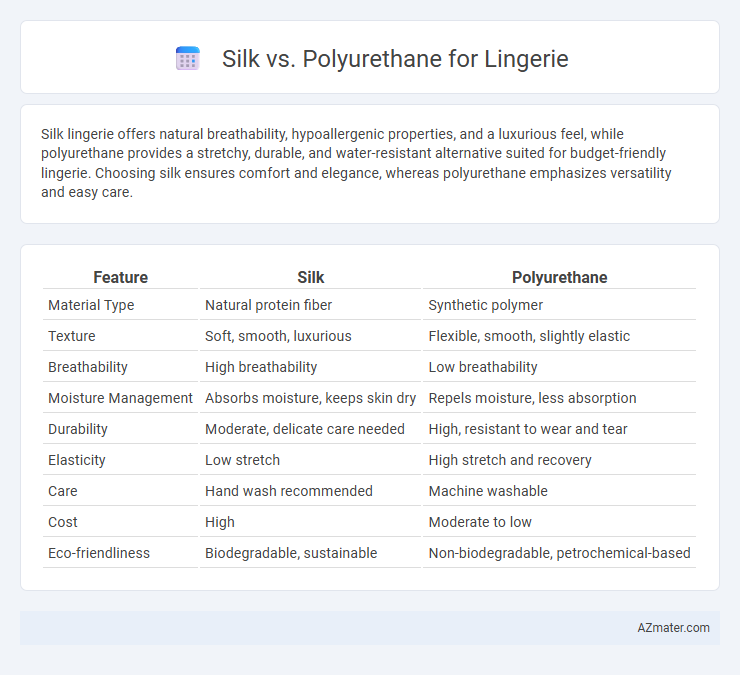Silk lingerie offers natural breathability, hypoallergenic properties, and a luxurious feel, while polyurethane provides a stretchy, durable, and water-resistant alternative suited for budget-friendly lingerie. Choosing silk ensures comfort and elegance, whereas polyurethane emphasizes versatility and easy care.
Table of Comparison
| Feature | Silk | Polyurethane |
|---|---|---|
| Material Type | Natural protein fiber | Synthetic polymer |
| Texture | Soft, smooth, luxurious | Flexible, smooth, slightly elastic |
| Breathability | High breathability | Low breathability |
| Moisture Management | Absorbs moisture, keeps skin dry | Repels moisture, less absorption |
| Durability | Moderate, delicate care needed | High, resistant to wear and tear |
| Elasticity | Low stretch | High stretch and recovery |
| Care | Hand wash recommended | Machine washable |
| Cost | High | Moderate to low |
| Eco-friendliness | Biodegradable, sustainable | Non-biodegradable, petrochemical-based |
Introduction: Silk vs Polyurethane in Lingerie
Silk lingerie offers natural breathability, hypoallergenic properties, and a luxurious, smooth texture that enhances comfort and elegance. Polyurethane lingerie, often crafted as faux leather or coated fabric, provides durability, stretch, and a sleek appearance with water-resistant qualities. Choosing between silk and polyurethane depends on preferences for natural softness versus synthetic resilience and style versatility.
Material Composition and Properties
Silk lingerie is crafted from natural protein fibers produced by silkworms, offering breathability, hypoallergenic properties, and a smooth, luxurious texture that regulates temperature and wicks moisture effectively. Polyurethane lingerie, made from synthetic polymers, provides high elasticity, durability, and water resistance but lacks the natural breathability and softness of silk, often resulting in less comfort during extended wear. The choice between silk and polyurethane impacts the lingerie's tactile feel, moisture management, and skin sensitivity, making silk ideal for comfort and luxury, while polyurethane suits form-fitting, durable styles.
Comfort and Wearability
Silk lingerie offers unparalleled softness and breathability, making it ideal for sensitive skin and long-term comfort. Polyurethane lingerie provides durability and stretchability, enhancing fit and support but may cause less breathability and trap heat. Choosing between silk and polyurethane depends on prioritizing natural comfort versus flexible wearability.
Breathability and Moisture Management
Silk offers superior breathability and natural moisture-wicking properties, allowing air to circulate freely and keeping the skin dry and comfortable during wear. Polyurethane, being synthetic and non-porous, tends to trap heat and moisture, which can lead to discomfort and skin irritation over time. Choosing silk lingerie enhances overall comfort through effective moisture management and temperature regulation, making it ideal for sensitive skin and extended wear.
Durability and Longevity
Polyurethane lingerie offers superior durability due to its resistance to wear, stretching, and moisture compared to silk, which is more delicate and prone to tears and damage from frequent washing. Polyurethane's synthetic composition allows it to maintain shape and color over time, making it a longer-lasting option for daily wear. Silk requires careful handling and special care to preserve its natural fibers and luxurious texture, ultimately leading to a shorter lifespan with regular use.
Skin Sensitivity and Hypoallergenic Considerations
Silk lingerie offers a natural, hypoallergenic fabric that is gentle on sensitive skin, reducing irritation and allergies due to its breathable, protein-based fibers. Polyurethane, commonly used in synthetic lingerie, may cause skin irritation or allergic reactions in sensitive individuals because it lacks natural breathability and can trap moisture. Choosing silk lingerie benefits those with skin sensitivities by providing a soft, non-irritating material that minimizes the risk of contact dermatitis and promotes skin health.
Aesthetic Appeal and Finish
Silk lingerie boasts a natural sheen and luxurious softness that enhances its visual elegance and smooth finish, providing a timeless, high-end aesthetic. Polyurethane lingerie, often designed with a glossy or matte finish, offers a modern and edgy look but may lack the breathable, natural texture that silk provides. The aesthetic appeal of silk is characterized by its delicate drape and subtle luster, whereas polyurethane presents a more structured and synthetic appearance suitable for bold fashion statements.
Care and Maintenance Requirements
Silk lingerie requires gentle hand washing with mild detergent and air drying to maintain its softness and prevent fabric damage, as it is sensitive to heat and harsh chemicals. Polyurethane lingerie, often found in faux leather or coated fabrics, demands wiping with a damp cloth and avoiding prolonged exposure to direct sunlight to prevent cracking or peeling. Proper storage in a cool, dry place is essential for both materials to preserve their texture and extend the lifespan of the lingerie.
Sustainability and Environmental Impact
Silk lingerie is biodegradable and produced from natural protein fibers, making it a more sustainable option compared to polyurethane, a synthetic material derived from petroleum. The production of polyurethane involves hazardous chemicals and emits significant greenhouse gases, contributing to environmental pollution and resource depletion. Choosing silk supports renewable agricultural systems and reduces plastic waste, whereas polyurethane lingerie adds to microplastic contamination in ecosystems.
Price Comparison and Accessibility
Silk lingerie typically commands higher prices due to its natural fiber origin, luxurious texture, and labor-intensive production process, making it less accessible to budget-conscious consumers. Polyurethane lingerie, being synthetic and easier to produce at scale, offers a more affordable alternative with widespread availability in various retail outlets and online stores. This price difference significantly influences consumer choices, especially for those prioritizing budget and accessibility without compromising on style.

Infographic: Silk vs Polyurethane for Lingerie
 azmater.com
azmater.com